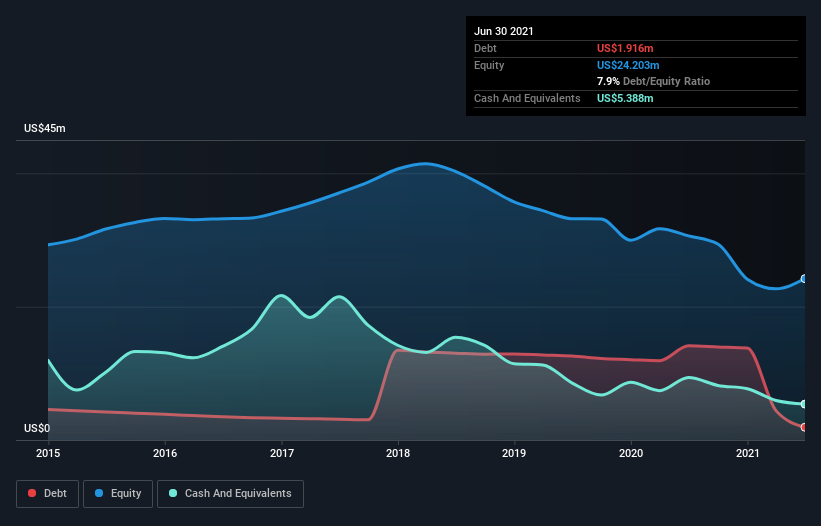Is CVD Equipment (NASDAQ:CVV) Using Too Much Debt?
The external fund manager backed by Berkshire Hathaway's Charlie Munger, Li Lu, makes no bones about it when he says 'The biggest investment risk is not the volatility of prices, but whether you will suffer a permanent loss of capital.' When we think about how risky a company is, we always like to look at its use of debt, since debt overload can lead to ruin. As with many other companies CVD Equipment Corporation (NASDAQ:CVV) makes use of debt. But the real question is whether this debt is making the company risky.
Why Does Debt Bring Risk?
Debt and other liabilities become risky for a business when it cannot easily fulfill those obligations, either with free cash flow or by raising capital at an attractive price. In the worst case scenario, a company can go bankrupt if it cannot pay its creditors. However, a more usual (but still expensive) situation is where a company must dilute shareholders at a cheap share price simply to get debt under control. Of course, the upside of debt is that it often represents cheap capital, especially when it replaces dilution in a company with the ability to reinvest at high rates of return. When we examine debt levels, we first consider both cash and debt levels, together.
See our latest analysis for CVD Equipment
How Much Debt Does CVD Equipment Carry?
You can click the graphic below for the historical numbers, but it shows that CVD Equipment had US$1.92m of debt in June 2021, down from US$14.1m, one year before. But on the other hand it also has US$5.39m in cash, leading to a US$3.47m net cash position.
How Healthy Is CVD Equipment's Balance Sheet?
Zooming in on the latest balance sheet data, we can see that CVD Equipment had liabilities of US$14.7m due within 12 months and no liabilities due beyond that. Offsetting this, it had US$5.39m in cash and US$2.93m in receivables that were due within 12 months. So its liabilities total US$6.40m more than the combination of its cash and short-term receivables.
Of course, CVD Equipment has a market capitalization of US$39.1m, so these liabilities are probably manageable. But there are sufficient liabilities that we would certainly recommend shareholders continue to monitor the balance sheet, going forward. Despite its noteworthy liabilities, CVD Equipment boasts net cash, so it's fair to say it does not have a heavy debt load! There's no doubt that we learn most about debt from the balance sheet. But you can't view debt in total isolation; since CVD Equipment will need earnings to service that debt. So if you're keen to discover more about its earnings, it might be worth checking out this graph of its long term earnings trend.
In the last year CVD Equipment had a loss before interest and tax, and actually shrunk its revenue by 31%, to US$15m. That makes us nervous, to say the least.
So How Risky Is CVD Equipment?
Statistically speaking companies that lose money are riskier than those that make money. And the fact is that over the last twelve months CVD Equipment lost money at the earnings before interest and tax (EBIT) line. Indeed, in that time it burnt through US$3.3m of cash and made a loss of US$6.6m. However, it has net cash of US$3.47m, so it has a bit of time before it will need more capital. Summing up, we're a little skeptical of this one, as it seems fairly risky in the absence of free cashflow. When analysing debt levels, the balance sheet is the obvious place to start. But ultimately, every company can contain risks that exist outside of the balance sheet. For instance, we've identified 5 warning signs for CVD Equipment (2 are a bit concerning) you should be aware of.
At the end of the day, it's often better to focus on companies that are free from net debt. You can access our special list of such companies (all with a track record of profit growth). It's free.
This article by Simply Wall St is general in nature. We provide commentary based on historical data and analyst forecasts only using an unbiased methodology and our articles are not intended to be financial advice. It does not constitute a recommendation to buy or sell any stock, and does not take account of your objectives, or your financial situation. We aim to bring you long-term focused analysis driven by fundamental data. Note that our analysis may not factor in the latest price-sensitive company announcements or qualitative material. Simply Wall St has no position in any stocks mentioned.
Have feedback on this article? Concerned about the content? Get in touch with us directly. Alternatively, email editorial-team (at) simplywallst.com.

